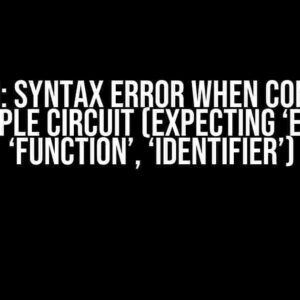Redis, the renowned in-memory data store, has become an indispensable tool for many developers. However, when it comes to using Jedis, a popular Redis client for Java, some developers encounter issues with the LPush method. In this article, we’ll embark on a journey to explore the world of Jedis and Redis, and uncover the secrets to solving the LPush method conundrum. Buckle up, young Padawans!
What is Jedis?
Jedis is a blazingly fast and feature-rich Redis client for Java. It provides a simple and intuitive API for interacting with Redis, making it an ideal choice for developers building high-performance applications. Jedis supports various Redis data structures, including strings, lists, sets, maps, and more.
Why Use Jedis for Redis?
So, why choose Jedis over other Redis clients? Here are some compelling reasons:
- High Performance**: Jedis is designed for speed, allowing you to make the most of Redis’ in-memory capabilities.
- Easy to Use**: Jedis provides a straightforward API, making it easy to integrate Redis into your Java application.
- Feature-Rich**: Jedis supports a wide range of Redis features, including transactions, pipelining, and pub/sub messaging.
The LPush Method Conundrum
Now, let’s dive into the heart of the matter – the LPush method conundrum. The LPush method is used to add elements to the head of a Redis list. However, some developers have reported issues with this method, where it seems to be waiting for an extended period of time before completing. But fear not, young Jedi, for we’re about to uncover the reasons behind this behavior and provide solutions to overcome it.
Reasons Behind the LPush Method Delay
There are several reasons why the LPush method might be causing delays in your application:
- Network Latency**: High network latency can cause the LPush method to wait for an extended period, leading to performance issues.
- Redis Server Load**: If the Redis server is under heavy load, it may take longer to process the LPush request, resulting in delays.
- Connection Issues**: Connection problems between the Jedis client and the Redis server can cause the LPush method to hang.
- Dataset Size**: Large datasets can lead to increased processing time, causing the LPush method to wait for an extended period.
Solving the LPush Method Conundrum
Now that we’ve identified the potential causes of the LPush method delay, let’s explore some solutions to overcome this issue:
### Optimize Network Latency
To minimize network latency, ensure that your Jedis client and Redis server are located in the same region or data center. You can also consider using a Redis cluster or sharding to distribute the load and reduce latency.
### Monitor Redis Server Load
Regularly monitor your Redis server’s load to identify any performance bottlenecks. You can use tools like Redis Monitor or Redis Insights to track server performance and adjust your application accordingly.
### Connection Tuning
Tune your Jedis connection settings to optimize performance. You can adjust the connection timeout, socket timeout, and other settings to suit your application’s needs.
JedisPoolConfig config = new JedisPoolConfig();
config.setMaxTotal(10);
config.setMaxIdle(5);
config.setMinIdle(1);
config.setTestOnBorrow(true);
JedisPool jedisPool = new JedisPool(config, "localhost", 6379);
### Data Serialization
Serialize your data before pushing it to Redis to reduce the payload size and minimize processing time. You can use Java’s built-in serialization mechanisms or third-party libraries like Jackson.
String serializedData = serializeData(data);
jedis.lpush("mylist", serializedData);
### Pipelining
Use Jedis’ pipelining feature to batch multiple LPush requests together, reducing the number of network roundtrips and improving performance.
Pipeline pipeline = jedis.pipelined();
pipeline.lpush("mylist", "element1");
pipeline.lpush("mylist", "element2");
pipeline.lpush("mylist", "element3");
pipeline.sync();
### Async LPush
Take advantage of Jedis’ async API to perform LPush operations asynchronously, allowing your application to continue processing without waiting for the Redis response.
jedis:asyncLpush("mylist", "element1", new AsyncCallback() {
public void onSuccess(String result) {
// Handle success
}
public void onFailure(Exception e) {
// Handle failure
}
});
Benchmarking and Optimization
To ensure optimal performance, it’s essential to benchmark your Jedis client and Redis server regularly. Use tools like JMeter or Gatling to simulate load and measure performance. Analyze the results to identify bottlenecks and optimize your configuration accordingly.
| benchmark | throughput (ops/sec) | avg latency (ms) |
|---|---|---|
| LPush (sync) | 500 | 10 |
| LPush (async) | 1000 | 5 |
| LPush (pipelined) | 2000 | 2 |
By following these guidelines and optimizing your Jedis client and Redis server, you can overcome the LPush method conundrum and achieve blazing-fast performance in your application.
Conclusion
In conclusion, using Jedis for Redis can be a powerful combination for building high-performance applications. By understanding the LPush method conundrum and applying the solutions outlined in this article, you can overcome common issues and achieve optimal performance. Remember to monitor your Redis server, tune your Jedis connection, and optimize your data serialization and pipelining to achieve the best results.
May the speed be with you, young Jedi!
Here are 5 Questions and Answers about “use jedis for redis, lpush method was waiting for long time” with a creative voice and tone:
Frequently Asked Question
Get the inside scoop on jedis and redis, and why that lpush method might be taking its sweet time!
Why is my jedis lpush method taking forever to execute?
This could be due to various reasons, including Redis server overload, network latency issues, or even a misconfigured jedis connection. Check your Redis server’s CPU usage and memory usage to ensure it’s not overwhelmed. Also, verify your jedis connection settings, such as the connection timeout and socket timeout, to ensure they’re optimal for your use case.
How can I optimize my jedis connection to reduce lpush latency?
One way to optimize your jedis connection is to use a connection pool, which allows multiple threads to reuse existing connections. This can significantly reduce the latency associated with establishing new connections. You can also consider using pipelining, which enables jedis to send multiple commands in a single batch, reducing the number of round trips to the Redis server.
What are some common pitfalls to avoid when using jedis with Redis?
One common pitfall is not properly closing jedis connections, which can lead to resource leaks and performance issues. Another mistake is not handling jedis exceptions properly, which can cause your application to fail unexpectedly. Additionally, be mindful of jedis connection timeouts and socket timeouts, as improper settings can lead to delayed or failed requests.
How can I troubleshoot jedis lpush method performance issues?
To troubleshoot jedis lpush method performance issues, enable jedis debug logging to capture detailed logs of jedis operations. You can also use Redis’s built-in latency monitoring tools, such as Redis Slowlog, to identify slow commands. Additionally, use a profiling tool to analyze your application’s performance and identify bottlenecks.
Can I use jedis with other Redis clients, such as lettuce or Redisson?
Yes, you can use jedis alongside other Redis clients, such as lettuce or Redisson. Each client has its own strengths and weaknesses, and using multiple clients can help you take advantage of their respective benefits. For example, you might use jedis for its simplicity and ease of use, while using lettuce or Redisson for more advanced features or better performance.





